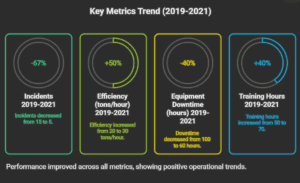Excavators are the lifeblood of the construction and earthmoving industries and have been for decades. They make our work easier and quicker with their wide range of functions.
Digging trenches? Lifting heavy stuff? No problem! But did you know that the pace of the excavator’s evolution has doubled? This is mainly due to technological advancements, eco-friendly measures, and the increased focus on safety and efficiency.
Changes in how the machine is designed and functions do not only mean better performance; they signal a complete transformation of how these heavy-duty machines work and fit in with modern construction methods.
First off, a whole range of cutting-edge technologies has turned excavators from straightforward mechanical contraptions into highly complex machines loaded with smart features.
These revolutionary solutions not only shoot the performance up but also deeply transform the way the operators work and the overall workflow on construction sites. So as the industry keeps on changing, it becomes pretty vital for the different stakeholders to grasp these innovations if they want to tap the full potential of the excavators in their projects.
Key Takeaways
- The innovative changes in excavators are the main factors that facilitate the evolvement of construction technologies leading to the efficient and productive job site operations.
- Integration of advanced technology in excavators, including GPS and telematics, leads to enhanced accuracy and precision in excavation operations.
- The design of excavators is influenced by sustainability and environmental considerations with emission and fuel consumption reduction as the main points of focus.
- Safety improvements in excavator operations, such as 360-degree cameras and proximity sensors, help in the prevention of accidents and injuries on construction sites.
- New exciting features and attachments for excavators, such as tiltrotators and hydraulic breakers, enable these machines to have a broader range of functions and thus a higher level of versatility.
Advanced Technology Integration in Excavators
One of the most revolutionary changes to day-to-day operations of excavators is the decision to integrate advanced technology into these heavy-duty machines. Without doubt, a major leap forward is the implementation of telematics systems allowing the monitoring of performance and health of machines in the real-time.
These setups fetch info on things like fuel consumption, engine hours, and maintenance needs thus letting operators and fleet managers have full control over the equipment utilization and maintenance management.
To give you an example, the two giants in this field, Caterpillar and Komatsu, have each created telematics solution that not only monitors the equipment but also guides the user towards less downtime and optimum efficiency in operation.
Besides that, the rise of automation and robotics in the field of excavator technology is leading us to a world of completely autonomous operations. Several companies are working on such a project where the only role of human is to allow the machine to do the job all by itself.
Volvo’s EC950F Crawler Excavator is a good example which has a sophisticated automation system that gives the machine the ability to precisely carry out the pre-programmed tasks.
So, it is not only production that gets enhanced but also the risk of mistake by the worker, which in turn leads to safer work sites, gets minimalized. Furthermore, GPS technology integration is making a big leap further to those inventions enabling operators to reach the highest degree of accuracy in digging provided by the exact real-time whereabouts data.
Sustainability and Environmental Considerations in Excavator Design
The worldwide concern about the environment has changed the construction industry as it now puts more and more emphasis on sustainability. Construction machines producers have agreed to decrease the cosmic wear of their products.
Among all the different trends, the one leaving the most remarkable impact is hybrid and electric excavator manufacturing, by which pollutant gases issue can be cut down drastically in comparison with that of fossil-fuel-powered machines.
For example, Hitachi ZX135US-6 hybrid excavator does this by using a conventional engine alongside an electric motor, thus the fuel consumption is decreased and less carbon dioxide is emitted into the atmosphere.
Besides switching to alternative power, the producers still find ways to make the parts of the machines more recyclable. Using less or more recycled and eco-friendly materials in the construction of machines is a trend that is gradually becoming common among the producers and JCB is leading the way by using recycled material in its units.
This does not only cut down the waste but also promotes the circle economy in the building sector. Additionally, innovations such as energy-efficient hydraulics are being employed to reduce the power used during operations, thus further extending the sustainability goals.
Safety and Efficiency Improvements in Excavator Operations
Safety issues have always been a big challenge in the construction sector but good news! Excavator innovations are now the solution to these problems, operator safety being enhanced in a big way.
Today, many types of heavy-duty equipment are installed with state-of-the-art safety features such as 360-degree cameras and proximity sensors that enable the operator to have an all-round view of the environment.

Given such facilities, accidents can be prevented from happening as the operators will be aware of all the hazardous situations and obstacles even if they do not look around themselves. As a matter of fact, many machines nowadays are using rearview cameras as their standard features which allows operators to move in tight spaces with more safety and at their own risk.
Apart from that, efficiency also gets a share of the up liftings through ergonomic designs which have been improved. The manufacturers are becoming more and more aware that the operators are long-time-in-the-cab kind of people and thus are working hard to come up with comfortable working conditions to avoid such operators’ fatigue.
Some features like the adjustable seating, user-friendly controls, and air-conditioners all contribute to a more pleasant working experience. Besides that, the progress made in the hydraulic field has resulted in shorter cycle times and better responsiveness enabling operators to carry out their tasks quicker and at the same time, maintain the safety standard.
Exciting New Features and Attachments for Excavators
The versatility of excavators has become even greater due to a plethora of new features and attachments designed to extend their capabilities. Among other great things, the idea of quick couplers that allow operators to switch between various attachments in the blink of an eye is the one that most excites people.
This invention practically lessens the inactivity time between tasks thus letting the workers go with the flow of the changing work demands without any troubles. For example, by means of a quick coupler, an excavator can shift from a digging bucket to a hydraulic hammer in no time.
Moreover, the breakthrough in the attachment technology has led to the birth of the specialized devices to increase users’ productivity across the wide range of applications.
To illustrate, tiltrotators allow the machine to not only turn the attachment 360-degrees but also keep the angle unchanged thus enabling accuracy in works like grading or trenching.
The ability to do this is very useful for those complicated projects where getting around is the key. In addition, manufacturers are building intelligent attachments supplied with sensors that measure the performance parameters and then give the information to the operator to adjust their usage based on the live data.
Case Studies of Successful Excavator Innovations
By looking through the lens of “real-life” scenarios, one can grasp very good the game changers that are innovating the industry of excavators. A very oft-cited example would be the industrial hybrid excavators utilization scenario of a large construction company engaged in extensive urban redevelopment projects.
Indeed, by injecting Hitachi’s hybrid technology into their machinery, the firm has reported a 30% decrease in fuel use than the traditional models, thus leading to significant savings on costs and being in harmony with their sustainability objectives through emission reduction during building operations.
There is also a first-rate instance stemming from the considerable infrastructure project wherein automated excavators were employed for earthmoving tasks. With the help of sophisticated GPS technology and machine learning algorithms, those excavators were capable of working independently and at the same time, following precise excavation plans.
The project manager pointed out that the innovation brought about a 25% rise in productivity together with cutting labor costs connected with manual operations. Such case studies demonstrate how embracing groundbreaking technologies can bring tangible benefits like more efficient, cost-effective, and environmentally friendly worksites.
Future Trends and Developments in Excavator Technology
If we look into the future, there are a bunch of different trends that are going to partly or fully determine the development of excavator tech. One major trend is the progressively deeper resort to automation and artificial intelligence (AI) within the realm of the excavators’ universe.
With the progress of AI algorithms, there will be machines not only performing tasks independently but also they will be able to learn from the surroundings and modify their operations accordingly. This means more efficiency at the work sites can be achieved as the machines self-optimize with respect to the present conditions.
Also, the usage of AR technology in the activities of an excavator holds a bright future for the performance and training of the operator. By AR, the operator can get a superimposition containing the vital data regarding the environment or project specifications, right inside his line of vision.
Hence the operator’s situational awareness as well as the decision-making capabilities during the complex tasks will be significantly improved. Moreover, with the further development of the Internet of Things (IoT), excavators will be more and more a part of smart construction ecosystems where the data exchange among the different machines will lead to an overall higher project efficiency level.
The Impact of Excavator Innovations on the Construction Industry
The changes to excavators that are making them quite different technologically to their predecessors are more than just tech news; they are a kind of fundamental shift in the way the construction projects are carried out.
By doing all these changes (integrating advanced technologies, putting sustainability first, enhancing safety measures, and extending operational capabilities through new features and attachments), excavators have become more efficient and effective than ever before. The case studies show that these changes give real benefits to the companies that are ready to bring in the changes.
As we turn our eyes to the coming days, we see that the technology of the excavators will not stay still but rather continue to change very fast and this is mainly due to the ongoing research and development which are aimed at meeting requirements of an increasingly complex construction landscape.
The changes brought about by these innovations will affect not only the way projects are done but also how companies take on the challenges of sustainability and safety in their operations.
The story of excavator break through is still going on; a good moment it is for the stakeholders who are willing to use these progresses and thereby achieve more in their endeavors.
